All About Cherry Pruning
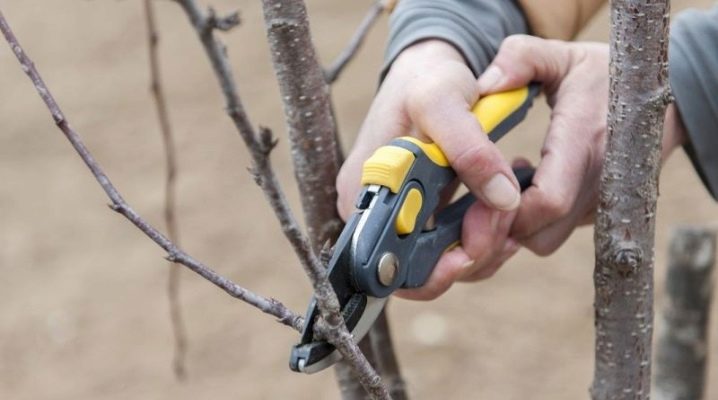
Cherry is distinguished not only by a rich and regular harvest in the form of tasty and juicy berries, but also by an unusually beautiful flowering. One of the keys to these phenomena is proper care, an integral part of which is pruning. Cherry pruning is one of the simplest procedures and does not require a lot of tools and time. And the reward will be, first of all, a bountiful harvest. All about the intricacies of pruning cherries can be read below.
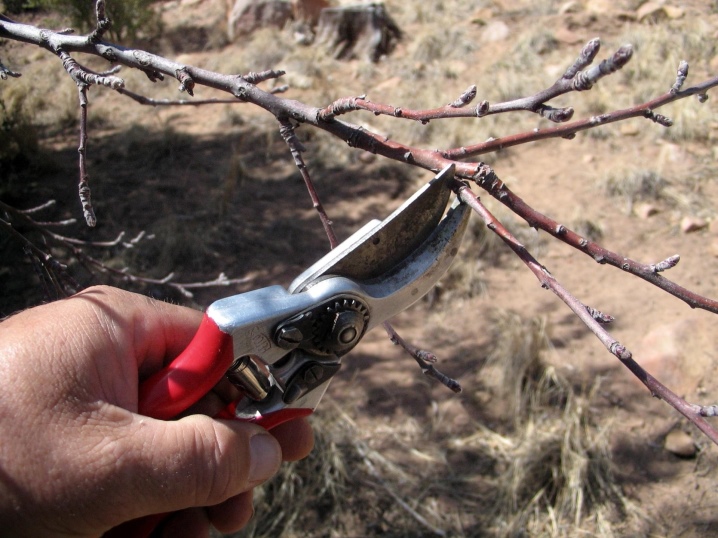
The need for a procedure
Pruning cherries, like many other fruit plants, is important and necessary for the reasons listed below.
- Formation of a beautiful crown. The asymmetrical crown makes it impossible to enjoy the beautiful appearance of the tree.
- With pruning, the tree bears better fruit. Gardeners whose main goal is to increase yields cannot do without pruning.
- Cherries grow quickly and well. For a relatively short period of time, the branches can grow and block access to light for the central branches. As a result, after pruning, the central branches will improve their health, and in the future, the likelihood of their drying will decrease.
- The tree tolerates wintering more easily after pruning.
- After removing some of the branches, the plant will have the strength to form buds. They will be laid more actively.
- Removing branches increases the immunity of the tree.
- Thinning branches, as already mentioned, gives more light and air to the central branches. This, in turn, to a certain extent prevents the appearance of fungi and some pests.
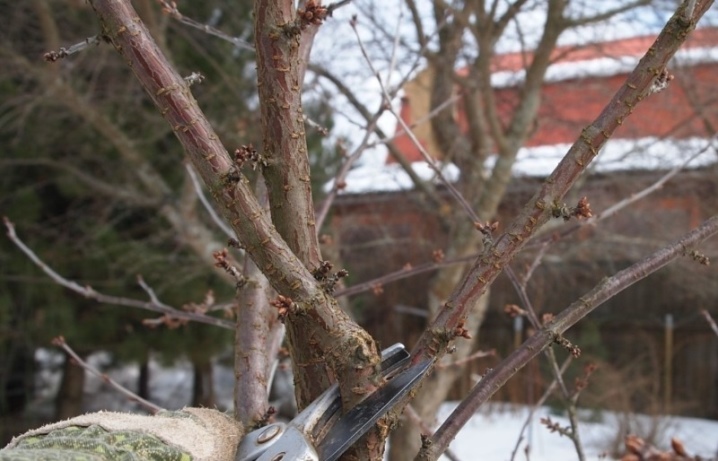
Too much pruning can lead to gum leakage. This is a painful phenomenon in which an amber liquid begins to flow from the bark or other parts of the tree. Cherries are often affected by this disease.
Timing
In general, cherry pruning should be done annually, but only slightly. A young seedling (especially if it was planted in early spring of this year) is cut before the buds swell, that is, almost immediately after planting. This helps the young tree to form the correct crown. Mature trees are cut at about the same time. The reason for this is that when pruning during this period, the tree does not suffer much due to the fact that the sap flow has not yet begun. If, for some reason, pruning was not carried out in early spring, then later (for example, in April) it is no longer necessary. Otherwise, the cut branches may dry out completely. The optimal period is the period from the second half of March to the first days of April.

Summer pruning is also practiced. It needs to be produced only for good, adult and strong specimens. This should be done only after fruiting is over and the crop is fully harvested. The optimal time for summer pruning is the last days of July and the first days of August. Pruning of this particular period affects the quality of the subsequent harvest.
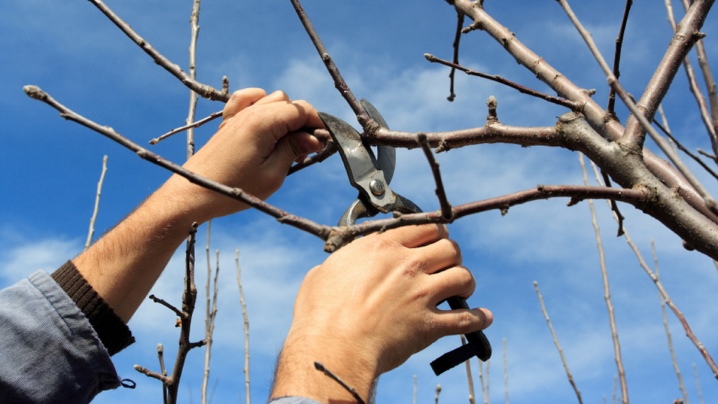
Another pruning is done in the fall. The optimum temperature for the procedure is considered to be in the range from -5 to 8 degrees. The procedure is sanitary - diseased branches are cut off. You also need to remove old, dried or partially dried branches. The tree spends the strength it needs to support them. Usually held from the second half of September until the first decade of October. Sap flow stops during this period.
It is not recommended to prune the tree during flowering.You can not cut off the branches before the whole ovary crumbles. Immediately after flowering, only thickening crowns can be removed.
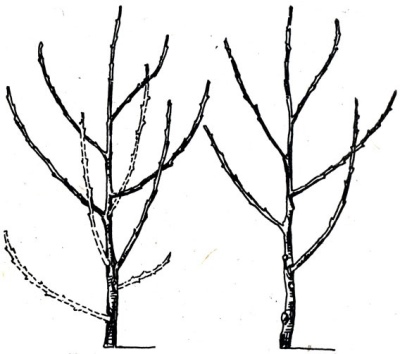
You can cut diseased and old branches at any time of the year. This is especially true for sick specimens. It is advisable to detect them as soon as possible and remove them quickly.
In the Moscow region, it is best to prune in early July. In this region, you can also carry out this procedure after the harvest. In cold areas (Siberia, Urals), pruning is carried out in May or June, with the onset of the first warming. As a rule, due to cold weather conditions, only sanitary crown thinning is carried out.
Some gardeners carry out pruning on certain days of the lunar calendar. The days of the waning moon are considered the most successful for this procedure.
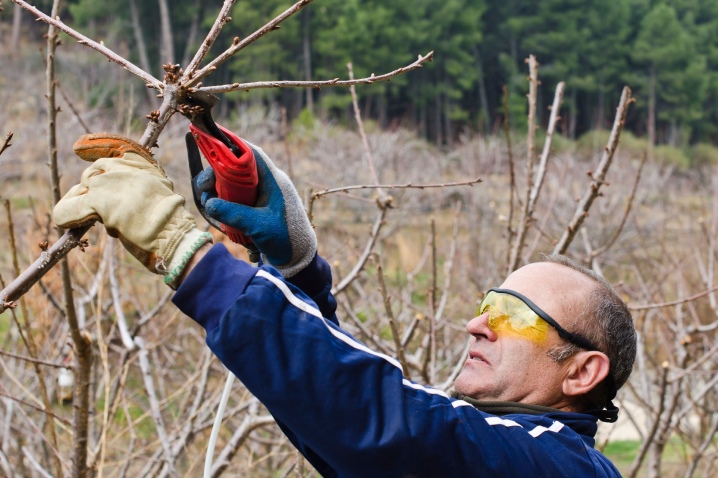
Views
In general, all the schemes described below can be applied to almost all varieties of cherries growing throughout the country.
Rejuvenating
The average lifespan of a tree is 12 to 15 years. Thus, anti-aging pruning can only be carried out after the plant reaches the age of 8 years. Obviously, the seedling does not need such pruning. You also need to carry out this procedure even if the annual growth of the tree has become less than 20 cm. The procedure for the first time is not performed in full, but "stretches" for 2-3 years. In the first anti-aging pruning, old, crooked and dried branches are removed. After that, the root shoots are also removed. Further procedures are carried out gradually and over the next 2-3 years. In a tree cherry, skeletal branches are cut off up to a noticeable lateral branch (you need to count from above). The same should be done with the branches located in the center of the crown. All branches are also shortened to about 40 cm for the top bud. In bush cherry, the branches are also trimmed to the first strong lateral branch. Unnecessary growth in the center is also removed. It is not necessary to shorten in this case. Felt cherry also removes excess branches, and all shoots are shortened to 60 cm in length.
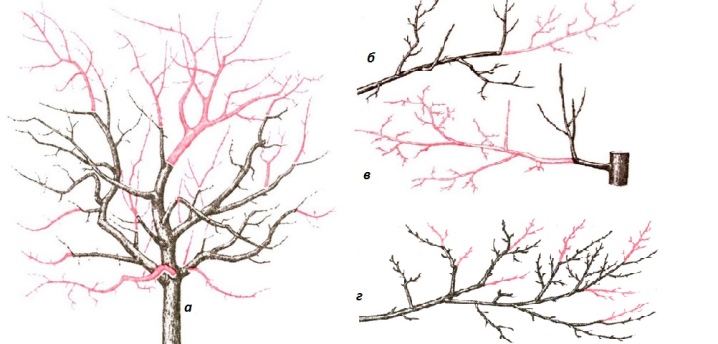
Formative
This type of pruning is carried out only on adult specimens in order to form the crown of the tree. This procedure is especially relevant for heavily thickened plants. It is held twice a year: in early spring and in summer. It is the most gentle type of pruning. If the tree has grown more than 2.5 meters in height, then it is pruned.
Formative pruning is usually done over several years to avoid damaging the tree.

Sanitary
This procedure is usually carried out immediately after harvest. As it might seem obvious, sanitary pruning involves removing diseased, damaged branches. Also cut off those that thicken the crown and form an acute angle with the trunk. It is advisable to identify branches that are already bearing fruit and cut them “into a ring”. With this cut, the branch will no longer grow. Root shoots are also removed. Branches with an annual growth of more than 50 cm are also cut to a length of about 30 cm.
The branches should be cut at a 40-degree angle in order to reduce trauma to the tree and to speed up the healing of the cut. Also held in the fall.
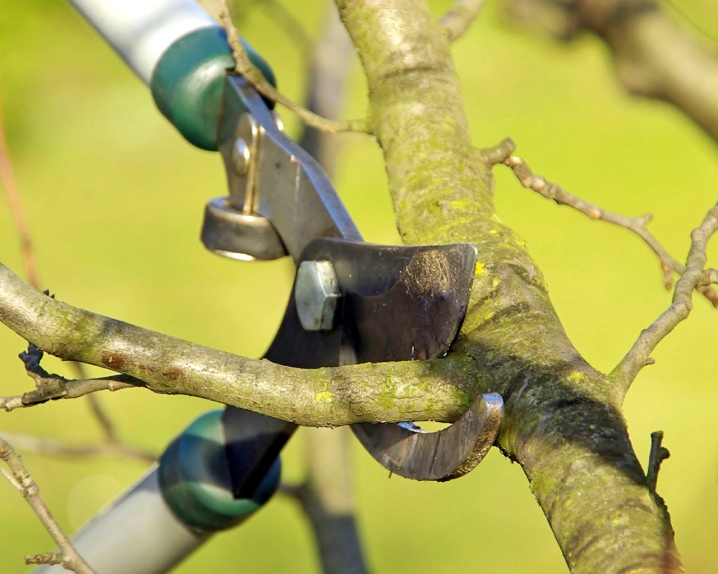
What tools are needed?
You don't need a lot of cropping tools. But all of them must be processed (disinfected) before use. Usually gardeners do it as follows: ignite on fire, wipe with a piece of cloth soaked in alcohol. You can also treat the tools with a rag soaked in a solution of copper sulfate with a 5% concentration.
- Garden saw. It is needed to cut old and dried branches. Often used specifically for anti-aging pruning.
- Another tool you may need is a pruner. They remove thin and young branches.
- The main tool for such work is the delimber. They can easily cut branches with a diameter of less than 2.7 cm.Also, this tool makes it possible to cut branches located in the depths of the crown.
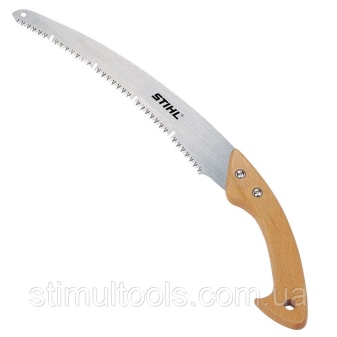
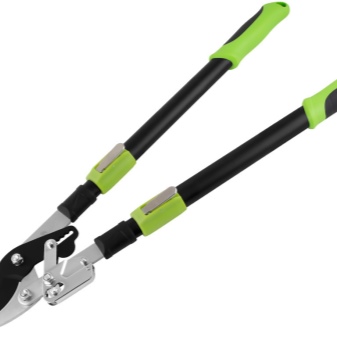
How to trim correctly?
It must be remembered that any pruning should be carried out on a dry day. It is advisable to conduct it in sunny weather. Also, immediately after the procedure, you do not need to treat the cut with an antiseptic solution - this must be done after it dries at least a little. Below are simple pruning schemes for beginners, taking into account such characteristics of cherries as variety and age.
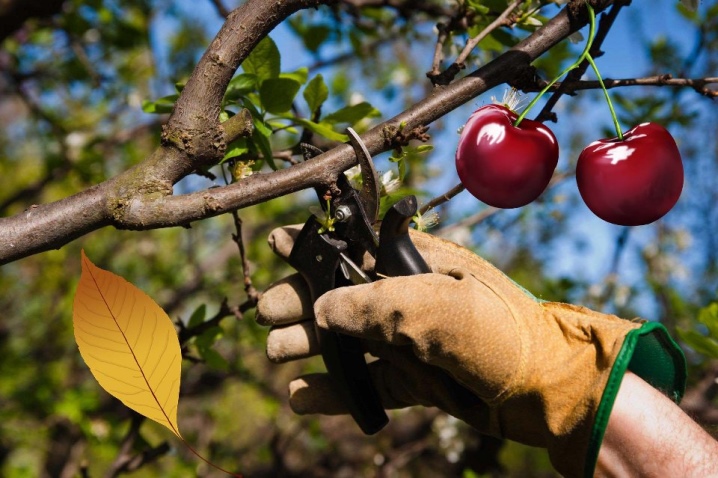
Given the type
There are three main types of cherries.
- Shrub (shrub) cherry. The average height is from 2 to 4 meters. It grows as a "bush" - 4–5 trunks go into the ground, forming a cup-shaped crown typical for shrubs. They bear fruit a lot and relatively easily. They tolerate frost well. In such varieties, sanitary pruning is carried out (diseased, affected and dried branches are removed) and from time to time, branches that exceed the annual growth rate are cut.

- Dwarf (felt) cherry. Dwarf varieties begin to bear fruit early (at about the age of 2-3 years). Therefore, light sanitary and formative pruning requires carrying out from the age of 1 year. One-year-old shoots are shortened by a third.
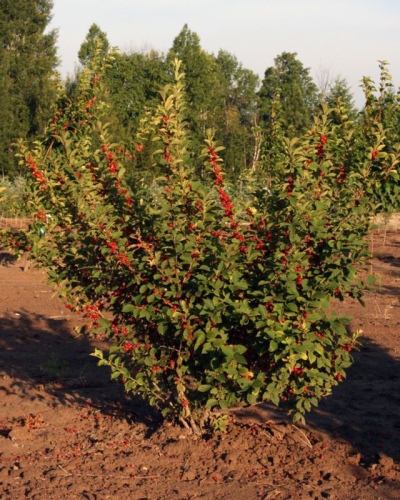
- Treelike (columnar) cherry. The height reaches about 5 meters. Pruning of columnar cherries is usually carried out to form the correct crown. Shortened to a height of 3-3.5 meters. Over time, such cherries also carry out anti-aging pruning.
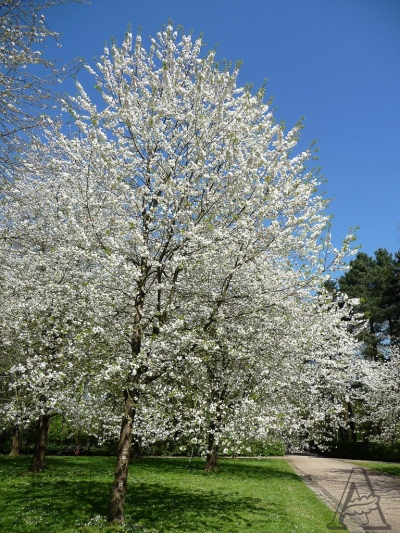
Taking into account the age
Summer pruning is done for plants over 3 years old. Mature cherries are best pruned in the summer after harvest. At this time, you can clearly see the amount of growth, diseased branches and the general condition of the crown. The main sign that a tree needs pruning is bare branches. As already mentioned, this applies only to mature trees. Old cherries require rejuvenating pruning. One-year-old shoots are usually lightly trimmed. Further, the skeletal and semi-skeletal branches of the tree are gradually shortened in different years. If the branches on the old cherry do not grow (there is no annual growth), then such a branch is completely removed.

Young cherry does not tolerate summer pruning. An exception may be branches that have crossed and become interfering with each other. In this case, intervention may be required. The first pruning after planting is carried out immediately. Simply put, as soon as the tree has been moved to a new location, it is immediately pruned. This helps to form the correct crown, and also prevents the tree from wasting energy on unnecessary branches. This only applies to seedlings. It is advisable to leave about 5 of the strongest branches on them for crown formation. In the second year after planting, branches are cut to thicken the crown of the tree. All shoots are shortened to a length of up to 50 cm. If a one-year-old cherry can be cut strongly, then a two-year one requires more gentle pruning. The goal is the subsequent formation of at least 10–15 skeletal (main) branches. Pruning a young tree must be done carefully. By cutting off the extra branches, you can easily start not only the wrong crown, but also poor yield.
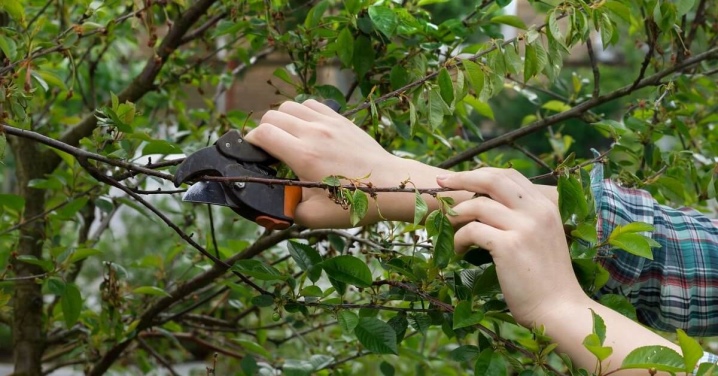
Follow-up care
Cherry maintenance, like pruning, is generally not labor intensive. The main part of the follow-up care is feeding. It should be done in late summer or early fall. Fertilizers such as potassium and phosphorus are applied to the area of the trunk circle. Thanks to this, next spring the cherry will "wake up" earlier than usual. Also in the fall (preferably in September), you need to carry out a good loosening of the soil around the tree.
It is imperative to water the tree well and regularly until the onset of the first cold weather.
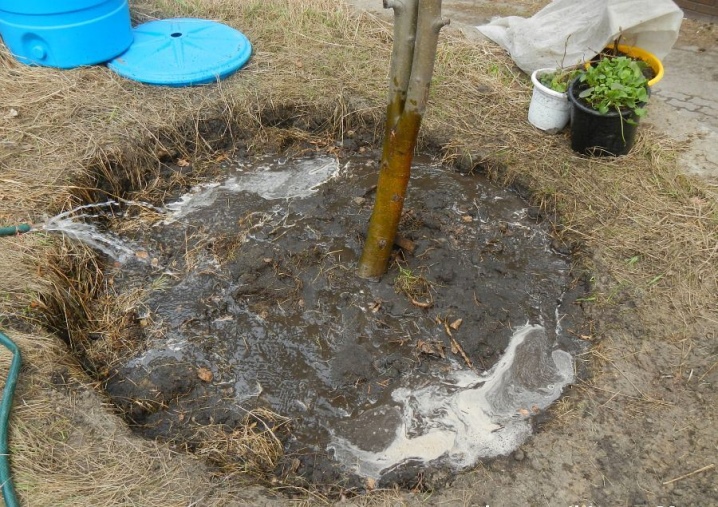
Major mistakes
Making the following mistakes can lead to weakening and subsequent disease of the tree.
- The optimal age when you can already begin to carry out this procedure in full without serious harm is 3 years.
- It is undesirable to prune trees during a particularly hot summer.
- Anti-aging pruning should be carried out not only for 2-3 years, but also in several stages throughout the summer. Thus, it becomes possible to improve the effectiveness of anti-aging pruning.
- If you transplanted an adult cherry, you can only trim it the next year.
- In the summertime, it is highly discouraged to remove skeletal branches.
- If the cut branches have been affected by pests, diseases or fungi, then it is best to immediately burn them in a distant corner of the site. Thus, it will be possible to destroy the harmful microorganisms living on them.
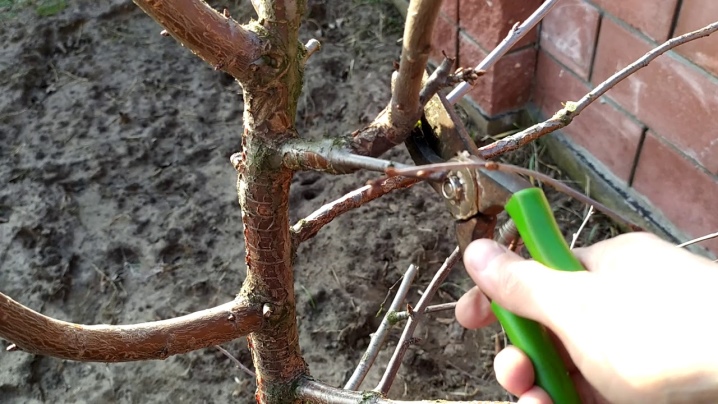







The comment was sent successfully.